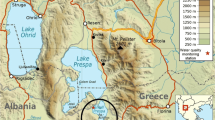Abstract
The goal of this research is to develop accurate and reliable forecasting models for chlorophyll ɑ concentrations in seawater at multiple depth levels in El Mar Menor (Spain). Chlorophyll ɑ can be used as a eutrophication indicator, which is especially essential in a rich yet vulnerable ecosystem like the study area. Bayesian regularized artificial neural networks and Long Short-term Memory Neural Networks (LSTMs) employing a rolling window approach were used as forecasting algorithms with a one-week prediction horizon. Two input strategies were tested: using data from the own time series or including exogenous variables among the inputs. In this second case, mutual information and the Minimum-Redundancy-Maximum-Relevance approach were utilized to select the most relevant variables. The models obtained reasonable results for the univariate input scheme with \(\overline{\sigma }\) values over 0.75 in levels between 0.5 and 2 m. The inclusion of exogenous variables increased these values to above 0.85 for the same depth levels. The models and methodologies presented in this paper can constitute a very useful tool to help predict eutrophication episodes and act as decision-making tools that allow the governmental and environmental agencies to prevent the degradation of El Mar Menor.
Access this chapter
Tax calculation will be finalised at checkout
Purchases are for personal use only
Similar content being viewed by others
References
Perez-Ruzafa, A., Marcos, C., Gilabert, J.: The ecology of the Mar Menor coastal lagoon: A fast changing ecosystem under human pressure. In: Coastal Lagoons: Ecosystem Processes and Modeling for Sustainable Use and Development (2005)
Ruiz, J.M., et al.: Informe de evolución y estado actual del Mar Menor en relación al proceso de eutrofización y sus causas. Informe de asesoramiento técnico del Instituto Español de Oceanografía (IEO) (2022)
U. P. Cartagena Servidor de Datos Cientificos del Mar Menor. https://marmenor.upct.es/docs/. Accessed 6 May 2022
Jimeno-Sáez, P., Senent-Aparicio, J., Cecilia, J., Pérez-Sánchez, J.: Using machine-learning algorithms for eutrophication modeling: case study of Mar Menor Lagoon (Spain). Int. J. Environ. Res. Public Health 17, 1189 (2020)
Yu, Z., Yang, K., Luo, Y., Shang, C.: Spatial-temporal process simulation and prediction of chlorophyll-a concentration in Dianchi Lake based on wavelet analysis and long-short term memory network. J. Hydrol. 582, 124488 (2020)
Cho, H., Park, H.: Merged-LSTM and multistep prediction of daily chlorophyll-a concentration for algal bloom forecast. IOP Conf. Ser. Earth Environ. Sci. 351, 012020 (2019). https://doi.org/10.1088/1755-1315/351/1/012020
Shin, Y.: Prediction of chlorophyll-a concentrations in the Nakdong river using machine learning methods. Water 12, 1822 (2020)
Pérez-Ruzafa, A., Marcos, C., Pérez-Ruzafa, I.M., Barcala, E., Hegazi, M.I., Quispe, J.: Detecting changes resulting from human pressure in a naturally quick-changing and heterogeneous environment: Spatial and temporal scales of variability in coastal lagoons. Estuarine, Coastal Shelf Sci. 75(1–2), 175–188 (2007). https://doi.org/10.1016/j.ecss.2007.04.030
Rumelhart, D.E., Hinton, G.E., Williams, R.J.: Learning internal representations by error propagation. In: Parallel distributed processing: explorations in the microstructure of cognition, vol. 1, pp 318–362. MIT Press, Cambridge, MA, USA (1986)
Hornik, K., Stinchcombe, M., White, H.: Multilayer feedforward networks are universal approximators. Neural Netw. 2, 359–366 (1989)
MacKay, D.J.C.: Bayesian interpolation. Neural Comput. 4, 415–447 (1992)
Hochreiter, S., Schmidhuber, J.: Long short-term memory. Neural Comput. 9, 1735–1780 (1997)
Hochreiter, S.: The vanishing gradient problem during learning recurrent neural nets and problem solutions. Int. J. Unc., Fuzz. Knowl.-Based Syst. 6, 107–116 (1998)
Shannon, C.E.: A mathematical theory of communication. Bell Syst. Tech. J. 27, 379–423 (1948)
Peng, H., Long, F., Ding, C.: Feature selection based on mutual information: criteria of max-dependency, max-relevance, and min-redundancy. IEEE Trans. Pattern Anal. Mach. Intell. 27, 1226–1238 (2005)
González-Enrique, J., Ruiz-Aguilar, J.J., Moscoso-López, J.A., Urda, D., Turias, I.J.: A comparison of ranking filter methods applied to the estimation of NO2 concentrations in the Bay of Algeciras (Spain). Stoch. Environ. Res. Risk Assess. 35(10), 1999–2019 (2021). https://doi.org/10.1007/s00477-021-01992-4
González-Enrique, J., et al.: Artificial neural networks, sequence-to-sequence LSTMs, and exogenous variables as analytical tools for NO2 (air pollution) forecasting. A case study in the Bay of Algeciras (Spain). Sensors 21, 1770 (2021)
Bergmeir, C., Benítez, J.M.: On the use of cross-validation for time series predictor evaluation. Inf. Sci. (Ny) 191, 192–213 (2012)
Friedman, M.: The use of ranks to avoid the assumption of normality implicit in the analysis of variance. J. Am. Stat. Assoc. 32, 675–701 (1937)
Hochberg, Y., Tamhane, A.C.: Multiple Comparison Procedures. John Wiley & Sons Inc., New York, NY, USA (1987)
Snoek, J., Larochelle, H., Adams, R.P.: Practical Bayesian Optimization of Machine Learning Algorithms. In: Pereira, F., Burges, C.J.C., Bottou, L., Weinberger, K.Q. (eds.) Advances in Neural Information Processing Systems, pp. 2951–2959. Curran Associates, Inc. (2012)
Acknowledgments
This work is part of the research projects RTI2018–098160-B-I00 supported by MICINN (Ministerio de Ciencia e Innovación-Spain) and “EnviroPorts. Investigación de técnicas de análisis y predicción de series temporales de parámetros ambientales y su interrelación con tráfico marítimo en entornos portuarios”. Expediente 2021.08.CT01.000044. Financiado por el Instituto de Fomento de la Región de Murcia (INFO) dentro del PROGRAMA DE AYUDAS DESTINADAS A CENTROS TECNOLÓGICOS DE LA REGIÓN DE MURCIA DESTINADAS A LA REALIZACIÓN DE ACTIVIDADES I+D DE CARÁCTER NO ECONÓMICO. MODALIDAD 1: “PROYECTOS I+D INDEPENDIENTE”.
Author information
Authors and Affiliations
Corresponding author
Editor information
Editors and Affiliations
Rights and permissions
Copyright information
© 2023 The Author(s), under exclusive license to Springer Nature Switzerland AG
About this paper
Cite this paper
González-Enrique, J. et al. (2023). Deep Learning Approach for the Prediction of the Concentration of Chlorophyll ɑ in Seawater. A Case Study in El Mar Menor (Spain). In: García Bringas, P., et al. 17th International Conference on Soft Computing Models in Industrial and Environmental Applications (SOCO 2022). SOCO 2022. Lecture Notes in Networks and Systems, vol 531. Springer, Cham. https://doi.org/10.1007/978-3-031-18050-7_8
Download citation
DOI: https://doi.org/10.1007/978-3-031-18050-7_8
Published:
Publisher Name: Springer, Cham
Print ISBN: 978-3-031-18049-1
Online ISBN: 978-3-031-18050-7
eBook Packages: Intelligent Technologies and RoboticsIntelligent Technologies and Robotics (R0)




